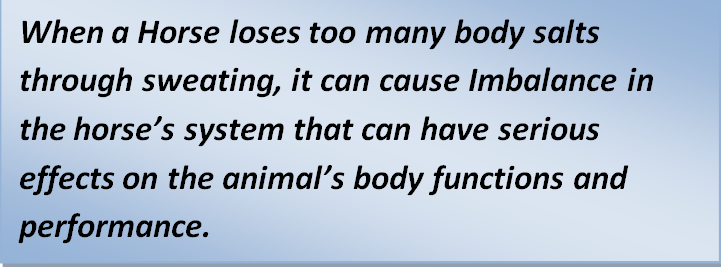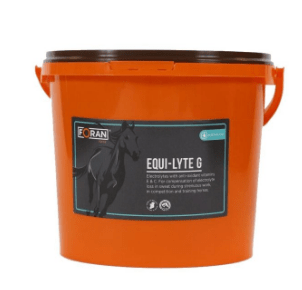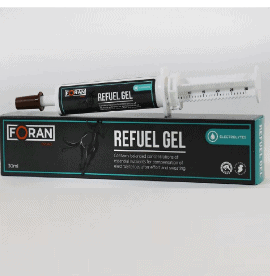Electrolytes is a word we are all familiar with and if you look there are plenty of equine electrolytes on the market. However before you jump in and buy do you actually know what they are and when to use them correctly?

Why do horses need them?
The horse’s diet contains a certain amount of naturally occurring electrolyte salts but if your horse is in any more than light work it is likely to require some supplementation of these salts due to losses in the production of sweat.
A heavily sweating horse needs to replace the salts and fluid they lose. Heat generated from exercise, a rise in ambient air temperature or fever can cause a horse to get too warm. When horses start to get too warm they must lower their body temperature to prevent overheating, this is usually done effectively by sweating.

The process of sweating causes the horse to excrete sweat through the sweat glands in the skin, the fluid evaporates and combined with other cooling mechanisms, effectively lowers the temperature of the body. If this is not done the horse will experience heat stroke with severe and sometimes fatal consequences. However along with fluid the horse loses “mineral salts”.
When the horse sweats excessively over a period of time then water and minerals can become depleted faster than they are replenished leading to dehydration. This causes confusion and the horse’s brain try’s to stop fluid loss and loses its thirst, so supplementation is required to rebalance the levels and ensure the body’s functions can continue.
What Are Electrolytes?

Electrolyte salts are a blend of minerals that are designed to replenish what the horse loses when it sweats.
Although water replacement is very important and horses need to be encouraged to drink, some of the minerals that are lost in sweat actually stimulate the horse’s thirst.
Loss of thirst is not a good sign. So to encourage the replenishment of fluid by drinking the horse needs to have the electrolyte salts in its system.
The horse’s natural diet is deficient in Sodium Chloride (common table salt) and it is good practice to add some salt to the feed of most stabled horses. As well as Sodium chloride commercial electrolytes contain other mineral elements that are lost when the horse sweats, these are essential for the horse to maintain its normal body function and fluid balance.
The main losses include; Sodium chloride and potassium with smaller amounts of calcium and magnesium. Phosphorous, manganese and copper are also lost in small quantities.
These minerals have vital roles in the body function such as, control of sweating, regulating thirst and urine output, nerve and muscle co-ordination and function and the production of energy, along with other functions within the body.
So when a horse loses too many of these salts in sweat it can cause these elements to become imbalanced and have a serious effect on the horse’s body function and performance.

Not all electrolytes are the same.
Many formulated electrolytes also contain glucose, this is to increase palatability however the product should not contain large quantities of sugar as these are not beneficial in electrolyte replacement. The product should taste salty to you.
Some electrolytes are specially buffered against acidosis and alkalosis and are for specific types of horse. Others are in a oil base to help protect the stomach lining. Others are specially formulated to redress loss due to scour. It is important to read the directions and uses on the product and to use them accordingly.
When does your horse need electrolytes?
Any horse that sweats freely for several hours will need some electrolyte supplementation.
The first group of horses that spring to mind are those of the high performance group that include, race horses, endurance horses, event horses, show jumpers, dressage horses and hunters. All these horses generate a lot of body heat from working and so sweat freely.
The second group are those that are sweating for other reasons, this could be an old pony with Cushing’s disease that has a thick curly coat in summer or a horse being travelled on a hot day, even a riding school pony at summer camp. High summer temperatures can cause horses to sweat for extended periods without working.
How to Give Electrolytes.

To replenish the salts lost by excessive sweating we can take 3 approaches to supplementation.
The first approach is to add an electrolyte powder to the feed of a hard working horse on a daily basis. The horse is used to the taste and accepts the supplement with the feed. The kidneys filter out the excess salts and they are excreted in the urine. This ensures the horse has an adequate supply of the required minerals. You cannot “pre Load” the horses system, all you can do is make sure there is enough as any excess will be lost.
A second similar approach to this is to add electrolytes to the horse’s water. Again the horse has to accept the taste in the water. To do this you need to use a bucket watering system which will also show you how much is normal for your horse to drink and can alert you to any abnormal consumption.
If you are adopting this approach then always use a 2 bucket system, this allows the horse a choice to drink the electrolyte water when it feels it needs it. It may take a number of days to allow the horse to become accustomed to the taste before it will drink so always keep a second bucket of clean water in the stable.

The third approach is to use an electrolyte shot or paste in a syringe. This can be useful for horses with palatability issues or when on a long ride out in hot weather to top up the lost salts during an extended period of exercise. They are useful for a quick overall recovery after strenuous exercise or transport and will also encourage a horse to drink within about 2 hours of administration.
Caution should be used if you think your horse is already dehydrated when administering this type of electrolyte and the horse should have free access to water.
Caution should also be used with ulcer prone horses as this can lead to a worsening of the condition, fat coated electrolytes should be used as these protect the stomach and still allow the salts to be absorbed.
No matter how you chose to supply electrolytes to your horse remember to read the product information and choose one that suits your horse depending on its work load and individual requirements, and always ensure your horse has access to plenty of fresh water. If you are in doubt then consult a veterinarian for advice about your horse’s individual needs.
This Article was originally published in our July 2019 Issue of Irish Sport Horse Magazine. Jessica Soley BHSI is a Level 5 Performance Coach and Senior Assessor for The British Horse Society. Having Competed and Run her own Competition Yard she is now an Equine Tutor for the QQI Equine Courses at level 5 & 6 , run by KWETB in Kildare.
